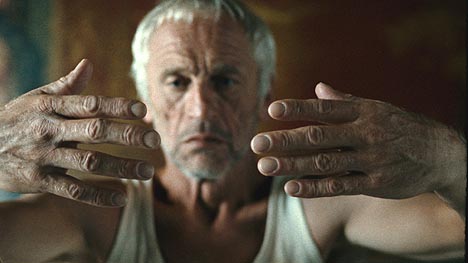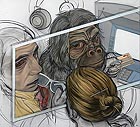
translated and summarized by: Liz Wollner-Grandville,
English summary April 1 - 5
Aargauer Kunsthaus
Fiona Tan – Rise and Fall
30.01.10 – 18.04.10
In the cocoon of memory
With her contribution to last year’s Venice Biennial at the Dutch Pavilion, the now 44-year-old Fiona Tan created an oasis of tranquillity for weary feet and fatigued eyes. The current exhibition at the Aargauer Kunsthaus in Aarau is presenting an extensive overview of her most recent videos, photographs, and drawings for the first time in Switzerland. And it is this meditative serenity that unites all of the works shown in Aarau. But don’t let yourself be deceived: the interfaces and fractures are what attract one’s attention in Fiona’s serene films – when image and sound levels ream the space-time-continuum and redefine them against all habits.
The video A Lapse in Memory (2007) makes one feel as if one has arrived in the midst of a dream. The artist provides stage directions from the off, while a dotard attempts to give his useless everyday routine some sort of structure. The house, witness to great, long gone times, and in which the old man dwells on his own, without any furniture, becomes a protective cocoon for the fragile figure. And with its endless rows of rooms and winding stairs it becomes a metaphor for a prison of memory, which is irretrievably lost with every door that snaps shut. The man shuffles along in the museum-like ruins of his life, but moves in circles, while image and text construct a hybrid personality between reality and fiction, in which he threatens to lose himself, or possibly even to dissolve.
The visually stunning works by the artist, who was born in Indonesia of Chinese and Italian descent, centre on the question of origin and identity. In her work Projection (2009) she presents a self-portrait - the title already insinuating the alter ego. Her whole body appears on a freely hanging surface in the room, which is accessible from both sides. As if moved by the wind, the multi-faceted image seems as if it liquefies in soft waves and constitutes itself without fixed contours in constantly new forms being and ceasing.
An ever-present motif in her works is water – once as gently churning waves, once as a reflective area, allowing time and flow to be experienced. Its free and thunderous fall over a cliff results in an exciting effect of both slow motion and simultaneous acceleration, on account of the whirl that forms over and over again at the same spot. Through this perpetual recurrence of the same, the forward movement of the image is retained - on account of the static of the camera and the eye of the viewer - through the paradox of a moving still-frame. Fiona Tan’s education in media art and painting at the Gerrit Rietveld Academy and the Rijksakademie van Beeldende Kunsten in Amsterdam becomes apparent in her genre-transgressing videos, as for example in her six-part series Provenance (2008), in which she seems to create paintings video methods. Immersed into Vermeer-like light structures, the small-format black-and-white views show scenes from a serene everyday life, and the slow camera work supports an intimate view of the meticulously staged protagonists.
The exhibition’s extensive arrangement does justice to the sequence of the content and the reference among the works themselves, as well as the technical scheme of her extremely diversified video works. In co-operation with the artist, the Aargauer Kunsthaus in Aarau placed numerous Black Boxes in the White Cube of its exhibition space, offering the works an optimal ambience, and allowing the atmosphere to unfold with the greatest possible effect.
By Sylvia Mutti
Aargauer Kunsthaus
5001 Aarau, Aargauerplatz
Tel: +41 062 835 23 30
Fax: +41 062 835 23 29
www.aargauerkunsthaus.ch
Opening hours: Tue – Sun 10 a.m. – 5 p.m. , Thu 10 a.m. – 8 p.m.
LukasFeichtner Galerie
Stylianos Schicho - perspex people (Adaptation of see-through humans)
12.03.10 - 10.04.10
Orwell on the Planet of the Apes
Planet of the Apes? No?! But one thing immediately becomes apparent: that ape-like protagonists come to the fore next to the human-like protagonists. And the correlation of both forms in the context of “cultural history” cannot be denied. Stylianos Schicho’s exhibition perspex people (adaptation of see-through humans) deals with today’s western capitalist society and the practice as well as the effect of extensive and differentiated surveillance. The starting point is not clear, but that is why the onlooker is distraught and worried by the glances of the figures looking directly at him or schizophrenic or apathetically upward, beyond the frame. The rooms are only insinuated, one cannot really locate them, but they are defined by individual returning elements such as credit cards, cell phones, headsets, remote controls, McDonalds/Coca Cola cups, with which the claustrophobically and densely packed figures are apprehended in front of money machines, one-armed bandits, and body scanners.
Stylianos Schicho’s meticulous painting technique and the originally objective character of the large format paintings, working with empty space and style elements of design and animation, transmit the depicted content through a shift in perspective of the view-axis into the onlooker’s momentary reality, opening a nearly paranoid presence of reciprocal examining and recording of individual everyday actions. In this show the apes are in control of capital; one encounters them in front of a money machine or behind a counter. Human beings, in their emotional isolation, are more part of a zombie film. In any case: exciting!
By Paul Gründorfer
LukasFeichtner Galerie
1010 Vienna, Seilerstätte 19
Tel: 512 09 10
Fax: 512 53 40
www.feichtnergallery.com
Opening hours: Mon –Fri 10 a.m. – 7 p.m., Sat. 10 a.m. – 5 p.m.
Generali Foundation
Danica Dakic – Role-Taking, Role-Making
22.01.10 – 16.05.10
Transformation of the migratory
In her allegorical video and film work, Danica Dakic, who was born in Sarajevo and grew up in Düsseldorf, examines values and traditions and their aesthetic transformation.
The artist presents the conjunction of these moments in her works displayed at the Generali Foundation, whereby the title of the video Role-Taking, Role-Making was eponymous for the exhibition. The reference to the Romany minority in Kosovo, the Roma Theater Pralipe, and the comments of a psychologist, combine reality and fiction on a musical and linguistic level - and thereby not only links to Romany forms of narration, but also to the exaggerated portrayal of characters known from classic dramatic acting.
The latter also applies to her video work Tauber Tanz (deaf dance), in which the artist refers to a traditional dance in Bosnia-Herzegovina. Dakic filmed members of a Bosnian dance group in Düsseldorf, all attired in historic theatre costumes, aesthetically charging the video by taking extreme close-ups.
In her work El Dorado, which she created for the documenta 12, the artist worked with under-age refugees in Kassel, who reveal their perceptions of life while standing in front of panorama wall paper at the Kassel Wall Paper Museum, emphasizing both their linguistic as well as their body-dynamic features. The actors’ global affinity is shown in a group photo taken in front of the wall paper El Dorado on a public square directly next to a freeway.
Mental imaginations merge with everyday reality, resulting from the migratory background of most of the protagonists in Dakic’s work - in which the transformation of customary personal circumstances is the requirement for the further advancement of individual patterns of tradition.
By Walter Seidl
Generali Foundation
1040 Vienna, Wiedner Hauptstrasse 15
Tel: + 43 1 504 98 80
Fax: + 43 1 504 98 83
foundation.generali.at
Opening hours: Tue – Fri 11 a.m. – 6 p.m., Thu 11 a.m. – 8 p.m., Sat and Sun 11 a.m. – 4 p.m.
Lentos Kunstmuseum Linz
Asta Gröting – Sculpture and Video
26.02.10 – 09.05.10
Less is more
How large should an exhibition with retrospective-character be? Or how small should it be? The question arises in view of the current one-woman-show of Asta Gröting’s works, which the Lentos museum announced as being their “largest solo exhibit to date”. Her works are displayed on two floors with a total of 1,200 square meters, but the number of works is rather sparse: there are only 24. 17 objects, primarily sculptures from 1989 to 2010, and a short video focussing on human conflict potential, showing a quarrel over a parking space, and a sketched sociogram – all of this can be seen in the huge hall on the upper floor. Seven videos of Gröting’s series of ventriloquist dialogues from 1998/2000 are shown in a darkened room on the lower floor.
Not that the unconventional German artist had a huge oeuvre to offer. Asta Gröting, who graduated from the Art Academy in Düsseldorf under Klaus Rinke in 1986, with Joseph Beuys as her mentor, is more of a slow, meticulous worker, who can be described as someone who searches, more than someone who decided to stick to a recognizable plan. But that is why this oeuvre amazes in its diversity and disparity. Paradox of the exhibition: it successfully mediates the stringency of this work with breathtaking rigor and sensuality, and simultaneously transports Gröting’s contextual interest, which can be circumscribed as sociological, cultural historical, philosophical, and anthropological. The heterogeneity of the forms and material used, representing a wide range of materials – ranging from Styrofoam pellets, magnetic pillars, pieces of iron, to epoxy resin, acrylic glass, and polyester, plays an equally important role as the seemingly loose course, inviting the visitors to get involved with the dialogs and excitement conveyed by the displayed pieces of art. The exhibition will later move on to the n.b. k. (Neue Berliner Kunstverein.
By Johanna Hofleitner
Lentos Kunstmuseum Linz
4020 Linz, Ernst-Koref-Promenade 1
Tel: +43 70 7070 36 00
www.lentos.at
Opening hours: daily except Tue from 10 a.m. – 6 p.m., Thu 10 a.m. – 10 p.m.
From May 1 – June 13, 2010 the exhibition will be shown at the Neue Berliner Kunstverein.
www.nbk.org
Mehr Texte von translated and summarized by: Liz Wollner-Grandville


 Teilen
Teilen



